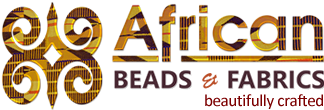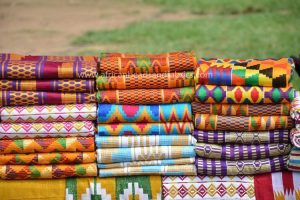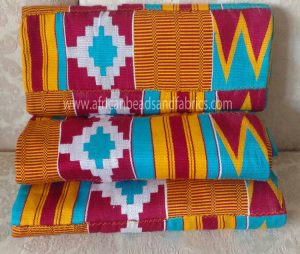Introduction
The name ‘kente’ refers to a brand of colourful loom-woven cloth originating from Ghana in West Africa. It is characterised by geometric multi-coloured patterns and bold designs and probably the best-known African fabric around the world with increasing in popularity in Ghana and in the African diaspora.
The name is derived from the Ashanti word “kenten” which means basket because it is an interwoven strip of silk or cotton fabric, and believed to have been largely inspired by the craft of a spider’s web. In researching this article we visited Bonwire and Adanwomase, two prominent kente producing towns in the Ashanti Region where we learned about the history of the fabric and the traditional methods of weaving it.
Origins
There are various versions about the origins of the cloth. Oral tradition has it that two brothers from the village of Bonwire went hunting one afternoon and came across a spider spinning a web. Amazed at the
beauty of the web, they were inspired to create something similar. The first kente cloth was consequently made out of black and white fibres from a raffia tree.
As tradition demanded as the time, the brothers presented their discovery to their tribal leader, the Asantehene (King of the Asantes or Ashantis)) who was extremely delighted and impressed. He adopted it as a royal cloth and encouraged its development as a cloth of prestige reserved for special occasions and encouraged them to make it extraordinary by weaving with different colours. This led to the dyeing of the black and white raffia threads to produce more colourful kente.
Colours
The traditional colours were red, green, and yellow. The weaving with raffia thread shifted over time to local cotton which was processed by women while the men wove the cloth. In the 16th and 17th centuries, the kente cloth associated with Asante royalty, was made of imported silk which made it an extremely costly fabric. Even though the emphasis on symbolism is still relevant in recent times, the materials used in making kente now include cotton and rayon, thus making it affordable for the larger population. Its use and range of colours has also evolved and it is now popular internationally.
- kente cloth comes in a myriad of largely bright colours
- more and more contemporary colours are available
- traditional colours
- modern kente colours
- combination of tradtional and modern
Perfecting the Craft
In Adanwomase we were informed that in 1697, the then Asantehene Osei Tutu I selected weavers from four Ashanti towns including Adanwomase, Asotwe, Bonyire, and Nsuta Beposo who traveled Bontuku , a trading center in the northern part of Cote D’Ivoire (Ivory Coast), to study the fabrics and perfect the art of hand loom weaving. Five families from Adanwomase were among the apprentices who learned the art of weaving in Bontuku.
All the apprentices returned safely after 14 years and settled in Manhyia (the Asantehene’s palace) to practice their art of weaving. They began weaving solely for the Asantehene at the time, Nana Osei Tutu. The weavers created their own styles and designs giving birth to the cloth which today is known as Ashanti kente. Originally certain kente designs were reserved for the use of the traditional Asante ruler.
Adanwomase has remained a royal weaving enclave for the Asantehene, and home to the Mfufutomahene (the chief responsible for weaving traditional black and white Kente cloth for Ashanti royals). The Mfufutomahene is the custodian of the “Seseε”, a small basket containing all historical samples of kente woven in Adanwomase. . Possession of the “Seseε” gives one the right to weave for the Asantehene.
Locations
Kente is woven in several parts of Ghana but predominately in the Ashanti Region and by the Ewes in the Volta Region of Ghana. The Ashanti version of kente with its characteristic patterns is the best known and most popular around the world.
In the Ashanti Region it is woven in specific locations like Kumasi, Bonwire, Adanwomase, Sakora Wonoo, Ntonso and Kwabre.
Kente Weaving in the Ashanti Region of Ghana
Kente weaving continues to contribute significantly to the economy of the kente weaving towns and villages of the Ashanti Region.
In Bonwire and Adanwomase a significant proportion of people of working age depend on the industry for their livelihood. The chiefs and people of the town view kente weaving as a very valuable treasure which requires sustaining into the future.
The different aspects of the industry include:
1. manufacturing and maintenance for the weaving looms,
2. retail of the materials required for kente production,
3. weaving, and,
4. retail of the fabric and promotion of the towns as tourist attractions for people from home and abroad who want to learn more about the fabric and its history.
Learning to be a weaver is a skill that children (mostly male) begin to pick up from a very early age by observing their father and older brothers working on the loom and in due course trying their hand at it. There is no dedicated school of weaving in the town and all the skills are learnt in an informal environment.
- wooden loom
- Trading in materials for kente weaving is major source of income
Reference
Ross DH (1998): Ghanaian Kente and African American Identity: UCLA Fowler Museum of Cultural History.

















